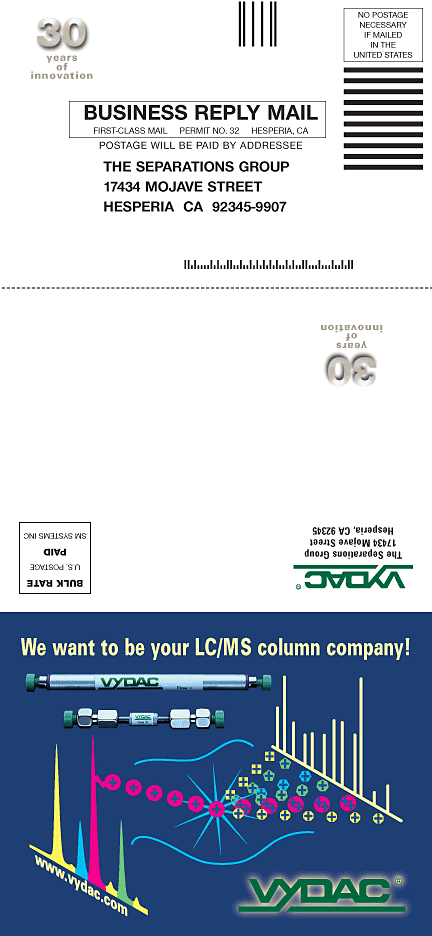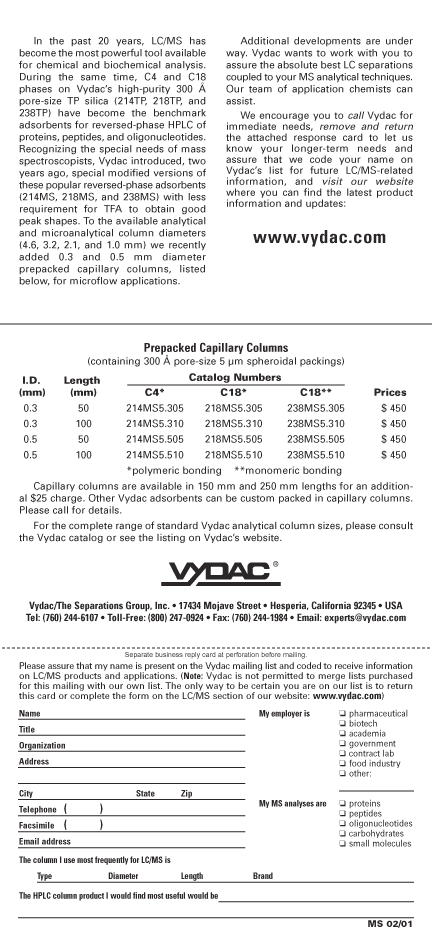

At both Millipore Corporation and Rainin Instrument Company, I managed marketing programs for laboratory supplies and small instruments that relied heavily on direct mail promotions. During those years, I conceived and designed numerous direct mailings that were highly successful in generating sales. My experience with direct mail promotion goes back to the late 1970's when I reported to Jack Mulvany, who at that time was Marketing Vice President for Millipore Corporation. Millipore Corporation classified sales prospects into two categories: Large-Dollar Applications, or LDLs, representing leads with potential greater than $1000 for the sale, and Small-Dollar Applications, SDLs, consisting of all leads with sales potential less than $1000. LDLs were considered worthy of followup by field-sales personnel, and, in fact, such personal followup was necessary in most cases to close the sale. SDLs, on the other hand, could not justify direct sales followup. The field-sales force could only make so many calls, and the profit potential of a Small-Dollar Application would not cover their cost if they were to become involved with every sale. However, for SDLs, because of the smaller commitment involved, if provided with sufficient information about product features and benefits many prospects would be willing to make a purchasing decision without a call or visit from a salesperson. To conceptualize the direct-mail mission, Jack Mulvany introduced the idea of the "indirect salesperson." Jack, with the aid of Millipore's corporate marketing communications group, set up a system to monitor the number of direct mail pieces sent out each month by each manager involved in small-dollar product marketing. If the number of mail pieces dropped below established goals, Jack would call the responsible marketing manager in for a talk. He would emphasize the need to maintain direct mailing levels by explaining that direct mail pieces should be viewed as "indirect salepeople" who could visit customers when a direct salesperson was not available. The greater the number of indirect salespeople you could send each month on customer visits, the more likely you were to get orders and meet your sales targets. A corollary to this concept, clearly, was that, like direct salespeople, the indirect salespeople must be effective in the selling mission. The rules for effectiveness were very similar to those for direct sales: Don't say too much. Listen first and learn: know your customer's needs. Introduce relevant features and benefits. Support the benefits with proof statements. Close: ask for the order. Provide complete information to allow the customer to complete the purchase and, if possible, an incentive to make the purchase decision now rather than postpone it. Jack Mulvany -- Big Red as he was known at Millipore -- a fun-loving Irishman -- was an extraordinary human being and an extraordinary salesman. He not only understood the need to sell products to customers, but also the need, as a corporate manager, to sell his management concepts to subordinates. He virtually never issued directives, but would sell, sell, sell relentlessly until he convinced you that his ideas made sense. Jack unfortunately perished in Millipore's tragic helicopter crash in the early 1980's, but I will never forget his advice, his approach to business management, and his underlying conviction that doing business should above all be fun -- a part of Millipore's 1970s business philosophy clearly inherited from founder Jack Bush. Another memorable influence on my understanding of direct mail promotions was Ed Fogg, who was Millipore's elder statesman of marketing communications during the time I worked there. Ed used to say, "The best direct mail piece is a simple cover letter." I drew from Ed my conviction that direct mail should always be polite, not rude. Like a polite direct salesperson, the polite indirect salesperson will always make the best impression on a potential customer and will be welcomed back on subsequent visits. The polite sell often ultimately succeeds where a strident, high-pressure or poorly designed (aka "junk mail") approach will fail. Millipore also understood the value of building a high-quality proprietary mailing list, making use of every available opportunity for recruiting new names, qualifying records according to interests, updating, and removing out-of-date information. In the 1980s and early 1990s, frequent direct mail promotions designed according to the principles I learned at Millipore had significant impact in building Rainin's business in hand-held pipetting products and chromatography supplies. I suspect the same principles should apply to direct email advertising, too. I drew on my experience in 2001 by designing the mailer shown on this page to assist Vydac's introduction of capillary-diameter HPLC columns for LC/MS applications. At that time, The Separations Group had no actual application data for LC/MS analyses performed using these new columns. Consequently, the mailer had to be dressed up with graphics of my own invention. |

|

|
Return to Seaview Scientific home page. |